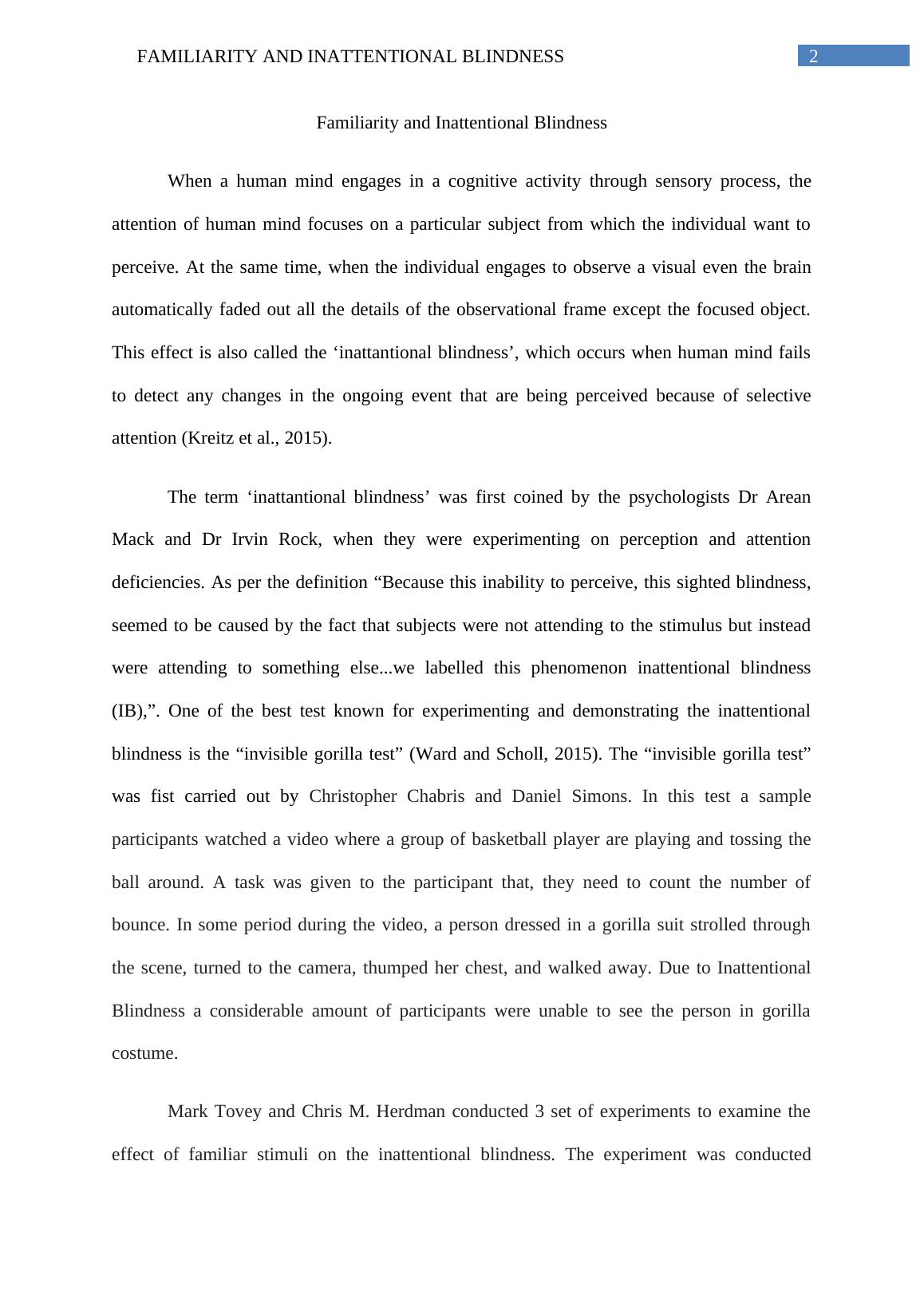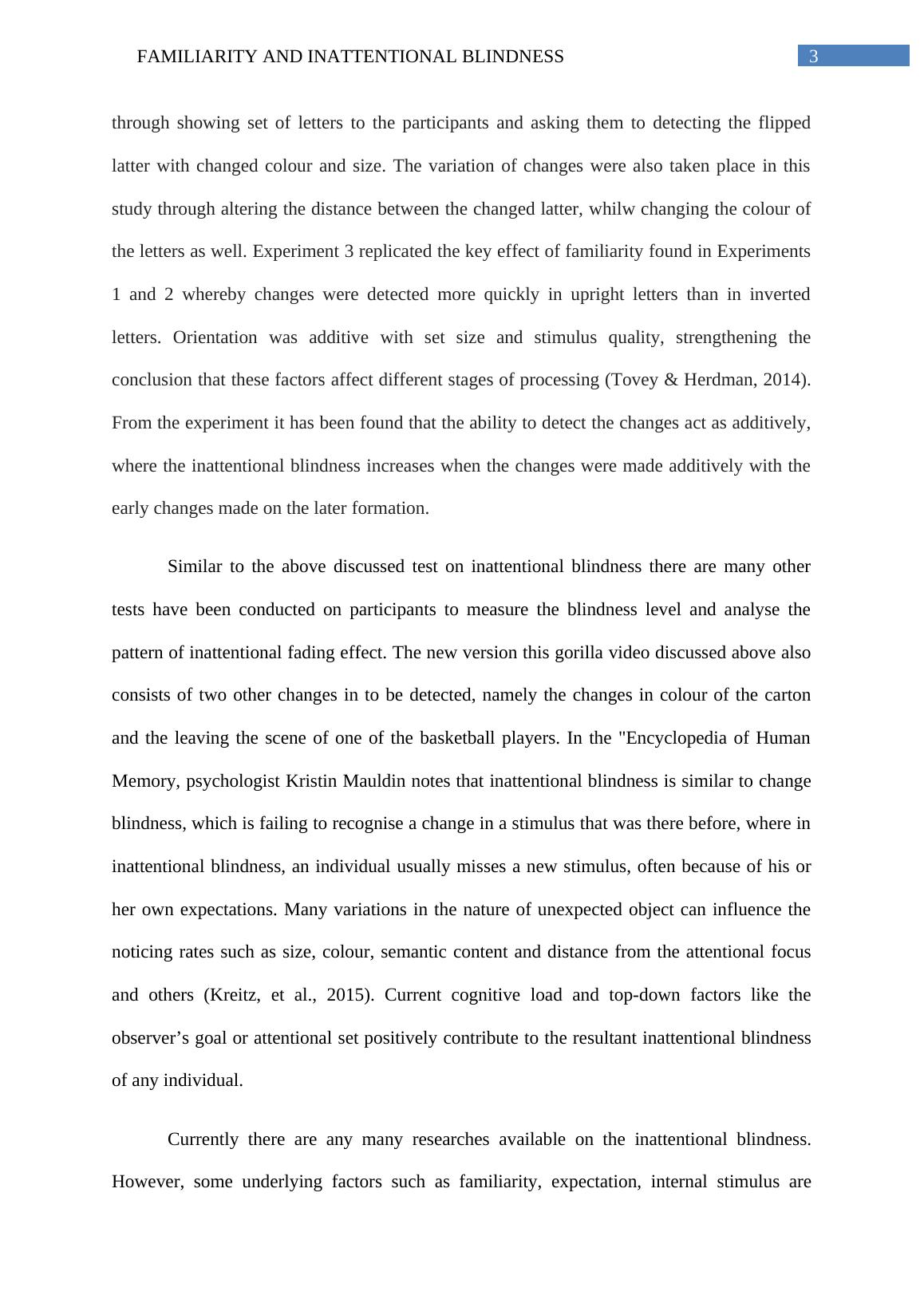Familiarity and Inattentional Blindness
Added on 2022-12-27
11 Pages2787 Words62 Views
Running head: FAMILIARITY AND INATTENTIONAL BLINDNESS
FAMILIARITY AND INATTENTIONAL BLINDNESS
Name of the Student
Name of the University
Author note
FAMILIARITY AND INATTENTIONAL BLINDNESS
Name of the Student
Name of the University
Author note

1FAMILIARITY AND INATTENTIONAL BLINDNESS
Abstract
When the individual engages to observe a visual even the brain automatically faded
out all the details of the observational frame except the focused object, which is called
‘inattentional blindness’. The aim of this research is to find out where there is any significant
interrelation between the familiarity and the ability to detect changes such as changes in
object and colour. From this research it has been found that familiarity with the event has
both direct and reciprocal relationship with the inattentional blindness, where adding a new
object of the observational frame has more potential to be detected in familiar observer,
however changes in colour and eliminating any object from frame has more potential to be
detected for unfamiliar observer.
Abstract
When the individual engages to observe a visual even the brain automatically faded
out all the details of the observational frame except the focused object, which is called
‘inattentional blindness’. The aim of this research is to find out where there is any significant
interrelation between the familiarity and the ability to detect changes such as changes in
object and colour. From this research it has been found that familiarity with the event has
both direct and reciprocal relationship with the inattentional blindness, where adding a new
object of the observational frame has more potential to be detected in familiar observer,
however changes in colour and eliminating any object from frame has more potential to be
detected for unfamiliar observer.

2FAMILIARITY AND INATTENTIONAL BLINDNESS
Familiarity and Inattentional Blindness
When a human mind engages in a cognitive activity through sensory process, the
attention of human mind focuses on a particular subject from which the individual want to
perceive. At the same time, when the individual engages to observe a visual even the brain
automatically faded out all the details of the observational frame except the focused object.
This effect is also called the ‘inattantional blindness’, which occurs when human mind fails
to detect any changes in the ongoing event that are being perceived because of selective
attention (Kreitz et al., 2015).
The term ‘inattantional blindness’ was first coined by the psychologists Dr Arean
Mack and Dr Irvin Rock, when they were experimenting on perception and attention
deficiencies. As per the definition “Because this inability to perceive, this sighted blindness,
seemed to be caused by the fact that subjects were not attending to the stimulus but instead
were attending to something else...we labelled this phenomenon inattentional blindness
(IB),”. One of the best test known for experimenting and demonstrating the inattentional
blindness is the “invisible gorilla test” (Ward and Scholl, 2015). The “invisible gorilla test”
was fist carried out by Christopher Chabris and Daniel Simons. In this test a sample
participants watched a video where a group of basketball player are playing and tossing the
ball around. A task was given to the participant that, they need to count the number of
bounce. In some period during the video, a person dressed in a gorilla suit strolled through
the scene, turned to the camera, thumped her chest, and walked away. Due to Inattentional
Blindness a considerable amount of participants were unable to see the person in gorilla
costume.
Mark Tovey and Chris M. Herdman conducted 3 set of experiments to examine the
effect of familiar stimuli on the inattentional blindness. The experiment was conducted
Familiarity and Inattentional Blindness
When a human mind engages in a cognitive activity through sensory process, the
attention of human mind focuses on a particular subject from which the individual want to
perceive. At the same time, when the individual engages to observe a visual even the brain
automatically faded out all the details of the observational frame except the focused object.
This effect is also called the ‘inattantional blindness’, which occurs when human mind fails
to detect any changes in the ongoing event that are being perceived because of selective
attention (Kreitz et al., 2015).
The term ‘inattantional blindness’ was first coined by the psychologists Dr Arean
Mack and Dr Irvin Rock, when they were experimenting on perception and attention
deficiencies. As per the definition “Because this inability to perceive, this sighted blindness,
seemed to be caused by the fact that subjects were not attending to the stimulus but instead
were attending to something else...we labelled this phenomenon inattentional blindness
(IB),”. One of the best test known for experimenting and demonstrating the inattentional
blindness is the “invisible gorilla test” (Ward and Scholl, 2015). The “invisible gorilla test”
was fist carried out by Christopher Chabris and Daniel Simons. In this test a sample
participants watched a video where a group of basketball player are playing and tossing the
ball around. A task was given to the participant that, they need to count the number of
bounce. In some period during the video, a person dressed in a gorilla suit strolled through
the scene, turned to the camera, thumped her chest, and walked away. Due to Inattentional
Blindness a considerable amount of participants were unable to see the person in gorilla
costume.
Mark Tovey and Chris M. Herdman conducted 3 set of experiments to examine the
effect of familiar stimuli on the inattentional blindness. The experiment was conducted

3FAMILIARITY AND INATTENTIONAL BLINDNESS
through showing set of letters to the participants and asking them to detecting the flipped
latter with changed colour and size. The variation of changes were also taken place in this
study through altering the distance between the changed latter, whilw changing the colour of
the letters as well. Experiment 3 replicated the key effect of familiarity found in Experiments
1 and 2 whereby changes were detected more quickly in upright letters than in inverted
letters. Orientation was additive with set size and stimulus quality, strengthening the
conclusion that these factors affect different stages of processing (Tovey & Herdman, 2014).
From the experiment it has been found that the ability to detect the changes act as additively,
where the inattentional blindness increases when the changes were made additively with the
early changes made on the later formation.
Similar to the above discussed test on inattentional blindness there are many other
tests have been conducted on participants to measure the blindness level and analyse the
pattern of inattentional fading effect. The new version this gorilla video discussed above also
consists of two other changes in to be detected, namely the changes in colour of the carton
and the leaving the scene of one of the basketball players. In the "Encyclopedia of Human
Memory, psychologist Kristin Mauldin notes that inattentional blindness is similar to change
blindness, which is failing to recognise a change in a stimulus that was there before, where in
inattentional blindness, an individual usually misses a new stimulus, often because of his or
her own expectations. Many variations in the nature of unexpected object can influence the
noticing rates such as size, colour, semantic content and distance from the attentional focus
and others (Kreitz, et al., 2015). Current cognitive load and top-down factors like the
observer’s goal or attentional set positively contribute to the resultant inattentional blindness
of any individual.
Currently there are any many researches available on the inattentional blindness.
However, some underlying factors such as familiarity, expectation, internal stimulus are
through showing set of letters to the participants and asking them to detecting the flipped
latter with changed colour and size. The variation of changes were also taken place in this
study through altering the distance between the changed latter, whilw changing the colour of
the letters as well. Experiment 3 replicated the key effect of familiarity found in Experiments
1 and 2 whereby changes were detected more quickly in upright letters than in inverted
letters. Orientation was additive with set size and stimulus quality, strengthening the
conclusion that these factors affect different stages of processing (Tovey & Herdman, 2014).
From the experiment it has been found that the ability to detect the changes act as additively,
where the inattentional blindness increases when the changes were made additively with the
early changes made on the later formation.
Similar to the above discussed test on inattentional blindness there are many other
tests have been conducted on participants to measure the blindness level and analyse the
pattern of inattentional fading effect. The new version this gorilla video discussed above also
consists of two other changes in to be detected, namely the changes in colour of the carton
and the leaving the scene of one of the basketball players. In the "Encyclopedia of Human
Memory, psychologist Kristin Mauldin notes that inattentional blindness is similar to change
blindness, which is failing to recognise a change in a stimulus that was there before, where in
inattentional blindness, an individual usually misses a new stimulus, often because of his or
her own expectations. Many variations in the nature of unexpected object can influence the
noticing rates such as size, colour, semantic content and distance from the attentional focus
and others (Kreitz, et al., 2015). Current cognitive load and top-down factors like the
observer’s goal or attentional set positively contribute to the resultant inattentional blindness
of any individual.
Currently there are any many researches available on the inattentional blindness.
However, some underlying factors such as familiarity, expectation, internal stimulus are

End of preview
Want to access all the pages? Upload your documents or become a member.
Related Documents
Effect of Familiarity on Inattentional Blindnesslg...
|5
|1233
|136
Introduction to Laboratory Report on The Human Mindlg...
|6
|1146
|184
